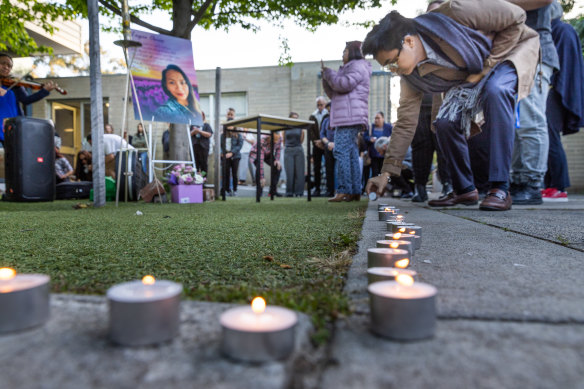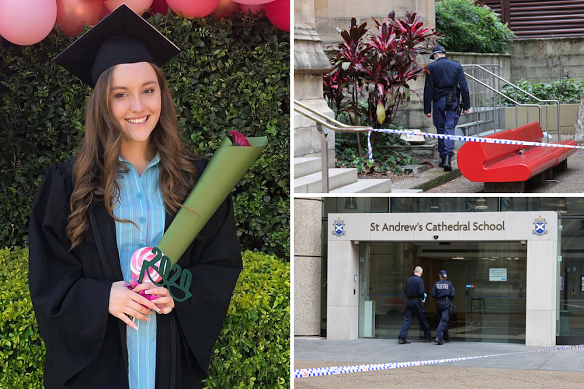This was published 1 year ago
Tracking men likely to kill: The radical proposal after five women dead in nine days
By Wendy Tuohy
Men flagged as potential killers would be GPS-tracked and monitored online under a radical proposal family violence experts want governments to consider after five women were killed in nine days.
As despair mounts about the failure to curb the numbers of Australian women seriously injured or allegedly killed by men, experts are calling for more direct intervention with “fixated” men – who stalk, harass, monitor or threaten intimate partners, but may not yet have offended.

Some of the women who died violently in the second half of this year: Top row, left to right, Analyn “Logee” Osias, Lilie James, Tayla Cox, Krystal Marshall, Alice McShera and Drew Douglas. The men accused of being responsible are yet to face trial.Credit: Aresna Villanueva
They say a program designed in the UK to protect public figures, which is now also being trialled there for potential domestic violence perpetrators, should be introduced and trialled in Australia to de-escalate potential violence against women.
It would involve intelligence gathering by specialist police to find and observe men, possibly including GPS tracking of them and monitoring their online and social media activities, and bringing them in if their behaviour indicated they had moved into a violence-planning stage.
Experts including violence researcher Dr Hayley Boxall, formerly of the Australian Institute of Criminology and now with ANU, say rather than working with offenders to reform their behaviours after violence has commenced, more direct methods such as this could help stop violence before it happens.
National Domestic, Family and Sexual Violence Commissioner Micaela Cronin said the proposal, included in Boxall’s homicide research for Australia’s National Research Organisation for Women’s Safety (ANROWS), is worth considering given the “devastating” deaths of women in Australia this year.

The Bendigo Filipino Foundation held a prayer vigil for Longee Osias on Tuesday night.Credit: Jason South
The spate of women’s alleged murders around the country had distressed her deeply, and “it is very clear this year we’ve seen rates [of violence against women] increasing, not rates decreasing”.
“That’s what keeps me up at night; what is it we can do that will shift the dial?” said Cronin from the Northern Territory, where she will attend a landmark coronial inquest on Monday into the violent deaths of four Aboriginal women, allegedly by domestic partners.
Women including Perth family lawyer Alice McShera, 34; Bendigo mother-of-four Analyn “Logee” Osias, 46; and Lilie James, a 21-year-old water polo coach at a Sydney private school, all died violently between October 25 and 29.

Perth lawyer Alice McShera, 34, died at Crown Towers on Monday.Credit: Facebook
Men have been charged in the cases of Osias and McShera and are on or awaiting trial, but the suspected killer of James was found dead by police.
In 2023, 43 women have allegedly been killed in domestic and family violence incidents, along with 11 children.
The number of women who have died in intimate partner homicide per year in Australia has hovered about 68 since 1989-90, Australian Institute of Health and Welfare data shows, and intimate partner homicide is the country’s most common form of homicide.
This week the Australian Institute of Family Studies found one in three Australian teenagers had experienced intimate partner violence, and the New South Wales Bureau of Crime Statistics released data showing rates of domestic and family violence had not decreased in the last 12 years.
‘What we need to do in this country more is to really understand, and focus on, the men who kill women and use violence against women.’
Micaela Cronin, national Commissioner for Domestic, Family and Sexual Violence
Cronin said the majority of funding is devoted to keeping women safe, but she wants more devoted to changing the trajectory of men with the potential to use fatal violence on partners.
“What we know from Australian Institute of Criminology research [the Pathways to Intimate Partner Homicide] is that there are pathways into perpetration … and what we need to do in this country more is to really understand, and focus on, the men who kill women and use violence against women,” she said.
“We’ve moved women around, removed women from their homes to safe houses, we tell women not to go walking at night; all the attention is on what women can do to keep themselves safe rather than holding men who use violence accountable.”
Boxall’s proposal to introduce a system of monitoring and intervening with men who had not yet committed violence, but whose actions suggested they were likely to, “could be worth exploring”.
One-third of perpetrators of intimate partner homicides in Australia fit the “fixated threat” category of men who have not previously come to the attention of the justice system, Boxall found.

Lilie James, a water polo coach at St Andrew’s Cathedral School in Sydney, died from head injuries after being attacked in the bathroom of the school gymnasium, apparently by a man with whom she had a brief relationship.
“Despite being jealous, controlling and abusive in their relationships, (fixated threat) offenders were relatively functional in other domains of their life,” she wrote.
“In many cases they were typically middle-class men who were well respected in their communities and had low levels of contact with the criminal justice system.“
She found their behaviours escalated as the victim was perceived to withdraw from the relationship.
Boxall said a dedicated family violence Fixated Threat Assessment program, staffed by specialist intelligence-gathering police, would help to “keep eyes” on such men and allow police to gauge if and when they may pose a lethal threat.
Many men who go on to commit murder, but had not yet used violence, did show signs that could have helped prevent deaths, Boxall said. Dedicated threat assessment structures could give bystanders a way to get interventions started.
“In 25 per cent of cases, the perpetrator [of intimate partner homicide] has told friends and family members he was going to murder his partner,” Boxall said.
“In a number of cases there was evidence this was not followed up with a police report: in one case, he [the eventual perpetrator] told his golf buddies, ‘I’m going to kill her by smashing her head in with a golf club’, and he did it a few months later – but nobody had done anything.”
“We think we know that guys who will murder their partner look a certain way; but these are guys living among us.”
The death of Lilie James highlighted that progress is needed to understand who is capable of violence against their partner, and a more sophisticated threat assessment would be a tangible way to help find out.
Professor Michael Flood, a researcher sociologist at Queensland University of Technology who has written about engaging men and boys in violence prevention, agreed with Cronin and Boxhall that earlier intervention with men at risk of murdering their partners or ex-partners is “entirely warranted”.
He agreed that the focus had been primarily on victims and how they could avoid victimisation, and far more effort needed to be placed on changing young men’s attitudes towards women.
National Community Attitudes Towards Violence Against Women Survey data had revealed this year that, “a substantial proportion, particularly of young men, think it’s legitimate for men to dominate women in relationships,” he said.
“There is still a level of social tolerance of dominance and abuse in relationships that we have to address.” This would mean more education on healthy masculinity, and “the way harmful forms of masculinity feed into perpetration … we still need to scale the work with men and boys up much more”.
On the ground, police forces in New South Wales and Victoria have made strong, one-off family-violence blitzes this year, in which hundreds of people, many with outstanding warrants, were charged with various offences including weapons, firearm and drug offences.
But existing fixated threat assessment is focused on lone-actor, “grievance-fuelled violence” perpetrators such as terror offenders, not family violence prevention.
“Police will of course act if we identify a threat to any individual including a current or former partner,” a Victoria Police spokesman said. There are no plans to create a similar centre specifically for family violence.
“Any decisions around fitting trackers to family violence offenders is a matter for government,” the spokesman said. “Police see the devastating impact of family violence every day.”
Despite this, the Victorian government recently cut a quarter of jobs at the organisation leading family violence reforms, Family Safety Victoria, prompting fears progress made since the 2016 royal commission would be jeopardised.
Eighty-three people were killed in family violence homicides in the past five years in the state, Crime Statistics Agency figures show. Family violence incidents increased by 2.5 per cent in the past 12 months, with 93,091 acts committed across the state – equivalent to 255 a day.
A NSW police spokesman said the four-day Operation Amarok IV earlier this month was part of a sophisticated suite of strategies to target dangerous domestic violence offending, and police continue to conduct “proactive deployments”.
“Police continue to battle the perception that domestic and family violence is private business. We all have a part to play in stopping the senseless loss of life due to this crime,” they said.
What strategies will make a tangible difference to the numbers of deaths and serious injuries of women is something journalist and author Jess Hill has examined in wide research into family and domestic violence. She has found that those that focused on deterrence, and on high-risk perpetrators or serial offenders were among them.
“You make it clear to them that if they continue to offend, there will be swift and harsh penalties, but also offer them the opportunity to seek help and stop offending,” she said.
“But for me, things that work have always been whole-of-community responses. One of these would be enforcing age verification on young people’s access to pornography, which Hill believes is leading to increasing levels of sexual violence.
She also wants alcohol and gambling industries, whose products Hill says are contributing to domestic and family violence offending, to be held accountable.
The Victorian Minister for Prevention of Family Violence, Vicki Ward, said the government had invested $3.8 billion to improve prevention and responses to family violence and a further $23 million “to keep perpetrators of violence, in view, engaged and accountable”.
New approaches to intervention with serious-risk perpetrators were being tested at three trial sites, and a range of primary prevention activities with boys and men in education, sports and community groups was underway.
Kate Fitz-Gibbon, professor in criminology and director of the Monash Gender and Family Violence Prevention Centre, said Australia was already one of the world leaders in intimate partner violence prevention and response, but that “women are not safe in any country”.
“The scary thing is, we are probably one of the most advanced, which is what’s terrifying [about Australia’s death rate],” Fitz-Gibbon said.
“While Australia has committed unprecedented funding and action, we are still not stemming the tide, that’s what’s frightening.”
One promising strategy to prevent violence against women overseas, the so-called saturation model, involved a whole-of-community approach to boosting respect, equality and safety messages over time.
It involved working with boys and young men to change attitudes toward women through early intervention, plus ensuring women had access to all the services they needed to leave dangerous relationships and find secure housing and financial independence.
At present, women needing housing after fleeing violence may wait up to two years.
Fitz-Gibbon said because of the scale of violence against women in Australia, “we’re not going to be able to jail our way out of it”, and as well as providing enough services for victim-survivors work must be done to ensure attitudes and values shift.
Evidence about what strategies make a measurable impact on family violence statistics is “slow to come”, Fitz-Gibbon said. “We don’t know conclusively what works to stop people from using violence.”
Get the day’s breaking news, entertainment ideas and a long read to enjoy. Sign up to receive our Evening Edition newsletter here.